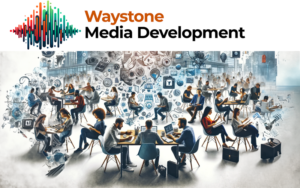In 2024, the media and publishing industries are witnessing a paradigm shift, primarily driven by intense mergers and acquisitions (M&A). This phenomenon, referred to as “Media Industry M&A Trends 2024,” is not just a fleeting moment but a fundamental reshaping of the media landscape. Understanding this trend is crucial for professionals, stakeholders, and enthusiasts alike, as it signals both opportunities and challenges within the industry.
Table of Contents
The Evolving Landscape of Media Industry M&A
Recent years have seen a flurry of M&A activities in the media sector. Giants in the industry are either consolidating to strengthen their market presence or diversifying to broaden their consumer base and service offerings. These mergers are not just about financial transactions; they’re reshaping how content is created, distributed, and consumed. The drivers behind these activities range from the need to harness technology and innovation, to the pursuit of greater market share and competitive edge in an increasingly digital world.
Impact of M&A on the Publishing Industry
The current wave of mergers and acquisitions (M&A) in the publishing industry marks a critical juncture, reshaping the very foundation of this sector. Both large conglomerates and small independent publishers are finding themselves at crossroads. The larger entities often pursue mergers to bolster their market dominance, expand their content libraries, and leverage synergies. On the other hand, smaller publishers sometimes merge out of necessity, seeking strength in numbers to survive in an increasingly competitive landscape.
This consolidation has far-reaching implications. Authors, who are the lifeblood of the industry, face a changing reality. Where once the path to publishing was relatively straightforward, now they must navigate a landscape dominated by fewer, larger entities, which could impact their bargaining power, contract terms, and even creative freedom. The consolidation can lead to streamlined operations and potentially more resources for marketing and distribution, but it can also mean less diversity in the types of books that get published.
For literary agents, the challenge lies in fostering relationships with a smaller pool of publishers while advocating effectively for their authors. And for readers, the impact is twofold. On one hand, they may benefit from higher-quality publications due to increased resources. On the other, there’s a real concern about the reduction in the diversity of voices and choices, as mainstream trends might overshadow niche or emerging genres.
Media Industry M&A Trends 2024: Strategic Responses to Industry Consolidation
Faced with these seismic shifts, companies within the publishing industry are strategically realigning themselves. One significant trend is the increasing reliance on technology. Publishers are utilizing data analytics to understand reader preferences better and are leveraging AI to streamline the editing and production processes. This tech-forward approach allows for more personalized content, which resonates with modern readers.
Furthermore, there’s a notable shift towards alternative business models. Subscription-based models and direct-to-reader sales platforms are gaining traction. These models offer readers a steady stream of curated content at a fixed price, benefiting both publishers and readers by establishing a more direct and consistent relationship.
The rise of independent and self-publishing is another notable trend. Platforms like Amazon Kindle Direct Publishing and others have democratized the publishing process, allowing authors to bypass traditional publishing houses altogether. This has led to an explosion of content, giving readers access to a broader range of material than ever before.
The Future of Media and Publishing Post-M&A
As the industry looks beyond the current Media Industry M&A Trends 2024, the future seems poised for significant transformation. Technology, especially AI and machine learning, will likely play a pivotal role in content creation and distribution. This could lead to more sophisticated and personalized reader experiences, as well as more efficient content production processes.
We may also witness the emergence of new forms of content consumption. For instance, the blending of traditional and digital media could give rise to hybrid models, where physical books come with digital enhancements like AR experiences or exclusive online content. However, challenges persist, particularly in ensuring a diverse range of quality content and maintaining competitive pricing in the face of a consolidated market.
The M&A trends in media and publishing are not just reshaping the industry; they are redrawing the boundaries of what’s possible in content creation and distribution. As these trends continue to evolve, staying informed and adaptable will be crucial for all industry players.
Conclusion
As “Media Industry M&A Trends 2024” continue to unfold, staying informed and adaptive is vital. For industry professionals and enthusiasts, understanding these trends is not just about observing market changes; it’s about actively participating in shaping the future of media and publishing. In this evolving landscape, the ability to anticipate and respond to changes will be key to thriving.
References
- Written Word Media. (2024). “Consolidation in Publishing.” Retrieved from [source link].
- EY. (2024). “Media Industry Deals and M&A Activity.” Retrieved from [source link].





